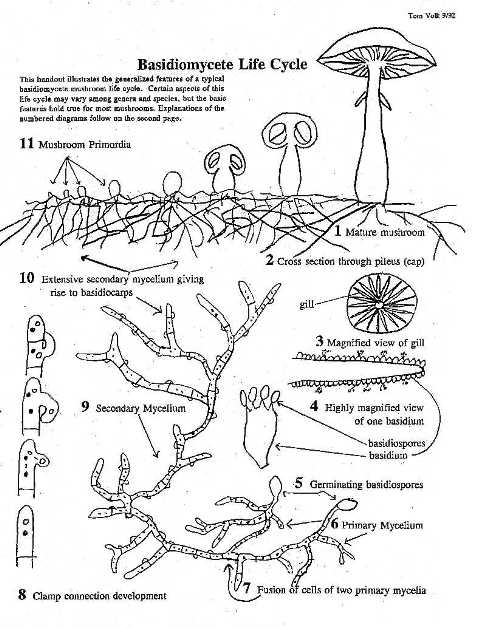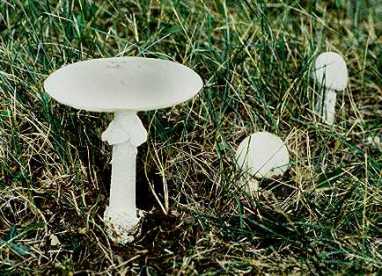Reproduction
Amanita bisporigera follows a similar reproductive method found
throughout phylum of Basidiomycota. The life cyle is
characterized by the production of external sexual spores from a
structure called basidia. These spores are haploid in nature.
After these spores are released into the environment, the two
haploid nuclei from each spore remain separate entities within
the fungal cell. The process of incorporating two haploid nuclei
into a cell is called plasmogamy The cell that contains
two haploid nuclei is said to be dikaryon. Fungi from this phylum remain in a dikaryon
stage longer than any other stage within the life cycle. This has
allowed the Basidiomycota to develop clamp connections or
outgrowths from the hyphae, which help cells to remain in
the dikaryon stage during hyphal growth and cell division.
The fusion of the two haploid nuclei only occurs within the basidia located in the gills of the fruiting body. This process is called karyogamy. After karyogamy occurs, the cells undergo meiosis and spores are formed. These spores are eventually expelled to the external environment. The process then repeats.
Source: Tom Volk Fungi
This picture describes the amount of time, in terms of ploidity, a fungal cell spends within the life cycle. Notice that number four most accurately describes Amanita bisporigera. Half of the life cycle is dominated by the dikaryon cell. Also notice how these life stages and life cycles vary depending on what fungi you are talking about.
Step 1 shows the complete development of the fruiting body. More importantly the complete development of the gills which contain the reproductive spores.
Step 2,3,4 shows the site of spore production within the fungus, starting from the largest structure (gills), to the smallest structure (basidiospores)
Steps 5,6 show the growth of a new mycelium and fungus from the parent spores that were released into the environment.
Steps 7,8,9 show how the fungus becomes more organized into larger mycelium from the original mycelium and parent spores. Notice how the clamp connections in step 8 allow for a dikaryon stage to exist.
Steps 10, 11 show how these secondary mycelium eventually give rise to the fruiting bodies known as mushrooms. The cycle then continues.
This picture shows the generalized life cycle of fungi within the phylum Basidiomycota. Amanita bisporigera follows a similar lifestyle.
Source: Tom Volk Fungi
Here is a photo that shows the different stages of the fruiting body. The one furthest to the left would be the most mature, or closest to sexual maturity. Notice in the Basidiomycota life cycle this would be the link between steps 11 and 1.
Continue to learn about the poison/toxin that Amanita bisporigera contains.
.jpg)

